A hip fracture or a broken hip can both be intracapsular (within the joint capsule) or extracapsular (outside the joint capsule) (fig. 1). Hip fractures are often very painful and costly in many ways. Most people who have a hip fracture need surgery to recover the fracture. Some even get a new hip. Mostly a hip fracture is a fragility fracture due to a fall or minor trauma in someone with weakened osteoporotic bone. In Denmark around 11.000 patients are hospitalized annually due to hip fractures – 85% of them have osteoporosis and the risk of re-fracturing is very high (20% experience a new hip fracture within 5 years).
In 2008 the number of hip fractures worldwide was 2.32 million but the number is expected to be escalating as the population ages. The number of hip fractures is expected to exceed 4.6 million before 2020 and 6.3 million in 2050.
Most of the falls happen in the person’s own home – mainly bedroom (28%), kitchen (15%) and stairs (15%)
4. What are the personal consequences of a hip fracture?
Hip fractures have high personal costs. Studies show that 50% of hip fractured patients never will regain previous independence (fig. 3) resulting in social isolation, lack of confidence and fear of falling, highly dependence of others help and some cannot remain in their own home. In the UK 78% of hip fracture patients come from their own home – only 46% are discharged to their own home and 10% never leave the hospital.
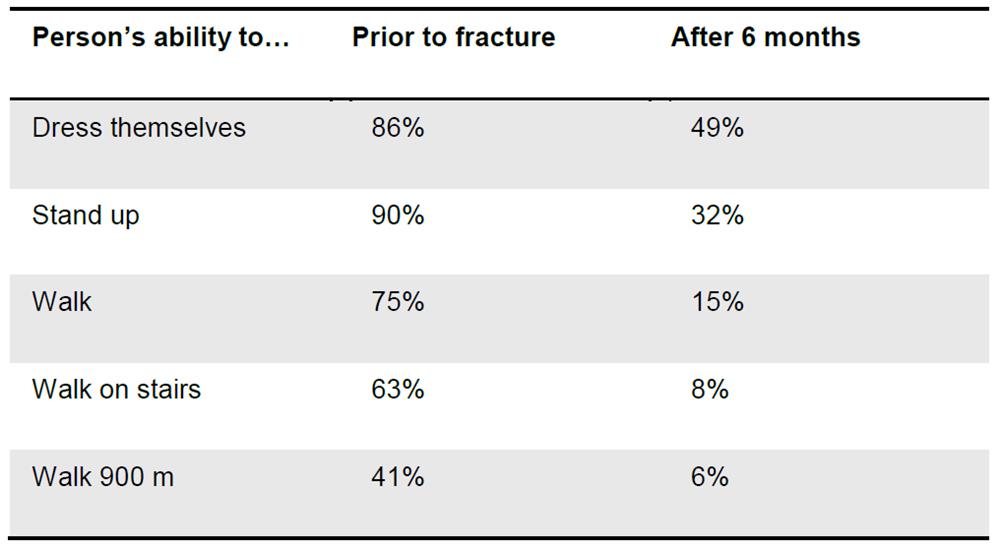
The result is often major loss of independence and quality of life due to lack of confidence and fear of falling. The more active the person was prior to the accident, the harder he/she will be hit by leading a more passive and sedentary life. In worst case a hip fracture might be life threatening. National Osteoporosis Society reports that 20% of all hip fracture patients will die within 12 months of their hip fracture - a rate which increases with age of the injured person. The mortality rate one year after a hip fracture for men above 85 years is 48 percent, for women 27 percent.
5. What causes a hip fracture?
90 percent of all hip fractures are caused by falls. As we get older, we get more fragile. Our bones get weaker and we get more insecure in all our movements. One in three senior citizens (above 65 years) falls every year. However, different factors influence the risk of fracturing a hip.
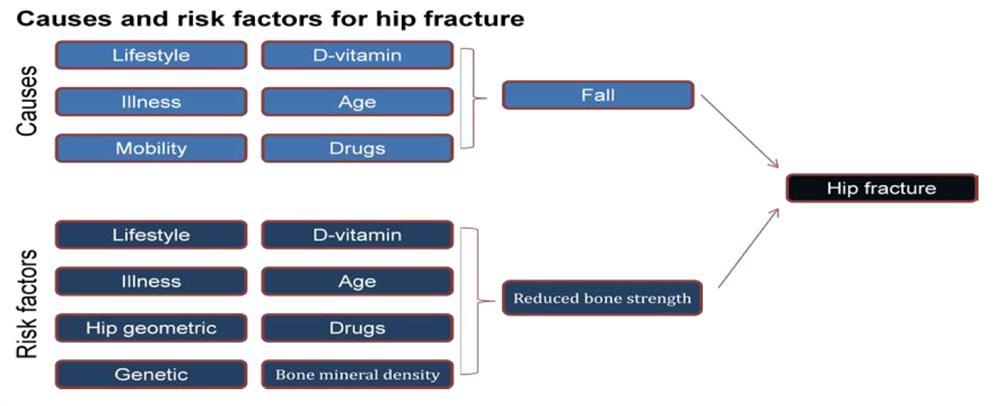
6. When is a person at high risk of fracturing a hip?
You are at high risk if you:
- have had fractures before
- suffer from osteoporosis
- have low bone density
- have relatives with osteoporosis, as it is hereditary.
- have never played much sport and are generally sedentary
- suffer from muscular weakness, balance disturbances and vertigo
- take medication, particularly tranquilizers, sleeping pills, adrenal cortex hormones, or drugs which lower blood pressure and blood sugar
- have dementia
- suffer from impaired hearing and vision
- have low blood pressure
- have experienced changes in environment (recently moved)
7. When and where should a person wear hip protectors?
Hip protectors should preferably be worn 24/7 as hip protectors only work when worn. Fall incidences can happen at all times, also during night time when a person for example have go to the bathroom.
8. How do you know that SAFEHIP® hip protectors work?
The SAFEHIP® hip protector is a pioneer in this field and the most clinical proven hip protector. It has been tested on more than 7,000 users. It has been under constant development and in 2006 the first horseshoe shaped shield was developed – SAFEHIP® Soft/Classic. The horseshoe design both absorbs and disperses the impact energy away from the critical area.
The continuous/standard protector shows maximum force right on top of the femur while the horseshoe design shows no force directly on top of the femur, but is dispersed to the soft tissue surrounding it.

In 2008 SAFEHIP® Classic was part of a clinical trial in Norway where hip protector was proved to have the potential of reducing the risk of hip fractures by nearly two thirds when worn correctly. The study included 1.236 nursing home residents from 18 nursing homes and the trial length was 18 months.
9. Why should SAFEHIP® hip protectors be used?
Prevention is better than cure. It is better to prevent falls and protect yourself in order to minimize the negative consequences of a fall.
However, not all risks of falls can be controlled or eliminated. Hip protectors are as such not a fall prevention initiative, as they don’t have an influence on the frequency of falls, but instead of the consequences of the falls. SAFEHIP® hip protectors can effectively and inexpensively reduce the risk of hip fracture by nearly two thirds.
Hip protectors should be seen as a product that contributes to a person’s own safety on the same level as seatbelt, lifejackets, helmets etc. It reduces the risk of serious injuries, saves money and improves the quality of life.
10. Why SAFEHIP® AirX™?
To meet the requests from the market of better comfort SAFEHIP® AirX™ was developed and introduced in 2008.
The SAFEHIP® AirX™ Shield is made of textile materials, which has great force reduction properties, and it is breathable. The breathability is an advantage for the user, as it allows the heat and sweat to evaporate and minimize excessive heat build up and thereby optimize compliance.
The AirX is further washable at high temperatures (95°C) - this makes it possible to wash pants and shields together (no need of removing the shield) which ensures that the shields are always placed correctly.
The breathability of different hip protector shields has been tested by EMPA, Switzerland. The shields were of different material: visco-elastic foam, encapsulated in plastic and AirX™. The result was clear; the AirX™ shield had significantly better thermo-physiological performance. The SAFEHIP® AirX™ shield was the most breathable hip protector shield resulting in a better wear comfort than the competitor shield and higher compliance.
11. Does SAFEHIP® AiX™ work as well as SAFEHIP® Classic?
The AirX™ shield has the same horseshoe shape as the SAFEHIP Classic shield and in laboratory studies the AirX™ shield has shown improved material properties and biomechanical performance compared to SAFEHIP® Soft/Classic shield. And as it is just a substitute of material, the clinical studies on SAFEHIP® Soft/Classic can be regarded as applicable for the SAFEHIP® AirX™.
The AirX™ Discreet shield is a thinner version of the AirX™ shield. The Discreet shield offers a discreet appearance while wearing a hip protector, yet it carries the same material properties as the AirX™ shield and has been biomechanically proven
12. Which standards does a hip protector have to meet to be proven effective?
Currently no international recognized standard exists.
For many years the Swiss EMPA test method for the biomechanical evaluation of hip protector performance of hip protectors has been the only real attempt to have a uniform test method. However, latest development is that after 2017, EMPA tests on hip protectors no longer exist, as EMPA and BfU, the Swiss Council for Accident Prevention, have terminated their cooperation.
The cease of this cooperation means that the validity of the current test certificates expires after 2017. For SAFEHIP® this is particularly good news, as SAFEHIP® was never approved by the EMPA test due to the horseshoe shaped shields, despite the fact that the shields carry substantial biomechanical and clinical evidence.
Tytex has never been able to recognize the EMPA test, the main reason being that the parameters for simulating a fall for an old person with osteoporosis were not correct. A study published in Journal of Biomechanical Engineering (Dec. 2008) proved that depending on several parameters, the ranking of different hip protectors differs. For example the stiffness of the soft tissue is an important parameter. If the stiffness of the soft tissue is low, soft hip protectors are ranked better, whereas if the stiffness is high, hard shell hip protectors are ranked better.
Most importantly, Tytex ranks the clinical evidence higher than any laboratory test method in all cases. Being a medical textile company, Tytex cannot compromise on medical function or comfort of the hip protectors we deliver and from the very beginning, Tytex has worked closely with healthcare professionals and users in the development of hip protectors.
13. Why is the effectiveness of hip protectors so difficult to prove?
The effectiveness of hip protectors has been the focus of several studies, and different types of tests have been developed to measure the shields’ effectiveness, unfortunately with different results. The different results are due to the many ways of testing the effectiveness of hip protectors. Many people focus on the biomechanical effect, but fall tests are some of the most difficult tests to perform. If one must establish the true effectiveness of a hip protector, a real test with the specific protector using real people over a significant time must be made – such test is called a clinical trial. SAFEHIP® is the most clinically tested hip protector.
Nevertheless, Cochrane has made a review of the different hip protector studies which indicates a consistency reduction in the number of fall related fractures. This supports the claim that population based approaches for prevention fall related fractures are effective.
Unfortunately, more studies have been excluded from the review due to different deficiencies. E.g. the Norwegian study including SAFEHIP® Classic is not part of the Cochrane review, due to lack of a randomized control group (people not wearing hip protector). In the Norwegian study it was seen as unethical and not a possibility to provide only some of the residents with hip protectors, all should be offered the possibility; thereby the control group were not completely randomized, but was offered the choice of using a hip protector. The main purpose of the study was to compare efficacy and compliance of SAFEHIP® Classic with SAFEHIP® hard hip protector.
Another issue when trying to prove the effectiveness of hip protectors is the lack of compliance with people living home. This may be related to the fact that the users at home don’t wear the hip protector to the same extent as in nursing homes, where users are under guidance and supervision all time. At home people with memory impairment might forget to wear the protectors, people with incontinence problems might find them too difficult to put on and take off all the time and as the hip protectors can be difficult to dress some people simply will need some help. Compliance issues may also appear from the fact that hip protectors affect appearance and tend to look “bulky” on the hips.
14. How can compliance be improved?
There has been found no clinically relevant difference in the acceptance and probability of continued use between soft and hard-shielded hip protectors in nursing homes. However, studies show that significantly more users of the soft hip protector used the protector 24 hours a day because they were more comfortable. Many users also prefer thinner shields and thereby discretion, when wearing hip protectors, not presenting with a visible “bulky hip” appearance.
Furthermore, compliance can be improved through:
- Motivation, education and proper instruction of users, relatives and caregivers in the use and importance of wearing the hip protectors.
- The use of hip protectors being followed by e.g. caregivers, making sure the user wears them.
15. Are hip protectors new on the market?
In 1993 the first hip protector was launched: SAFEHIP® with a hard shield. Much has happened since. The protecting shields have been under constant development to gain better results in the clinical and biomechanical tests as well as to meet the requirements from the customers of better comfort. SAFEHIP® are now at 5th generation.
16. Are hip protectors cost efficient?
Hip fractures do not only have high personal costs. Hip fractures have been identified as a major expense to health care systems. Hip fractures count for the most hospital beds. In the UK 78% of hip fracture patients come from their own home – only 46% are discharged to their own home and 10% never leave the hospital.
However, the actual cost-effectiveness of hip protectors is difficult to estimate as many parameters have to be taken into account e.g. risk reduction rate, size of target market: Gender, age, race, cost and number of hip protectors per patient, cost of educating healthcare personnel and patients, extra time of healthcare personnel to help dressing etc. Many of the parameters even differ from country to country so it is very complex to give an exact estimation of money saved when using hip protectors. The studies, which have been made on cost-effectiveness, focus on different parameters so they cannot be compared, but they all come to the conclusion that the use of hip protectors in high risk population are cost-effective.
The cost to the NHS (UK health system) for each hip fracture is between £25.000 and £32.000 per person which corresponds to the price of around 700 hip protectors. If just one hip protector prevents one hip fracture in a person, money and personal pain are saved. The number of hip fractures each year in the UK lies between 70,000 and 75,000 and the cost to the NHS and social care service is at least £ 2 billion per year.
A study from the US found that if each permanent nursing home resident at the age 65 or older was supplied with three hip protectors and they were replaced annually the weighted average lifetime absolute risk reduction of hip fractures would be of 8.5% resulting in net lifetime savings to Medicare of US$223 per resident. When the annual cost of hip protectors is less than US$151 per person and the relative risk of fracture is less than or equal to 0.65 with hip protector, or adherence greater than 42%, hip protectors were found to be cost saving to Medicare over a wide range of assumptions.
Extrapolating these results to the estimated population of American nursing home residents without previous hip fractures, Medicare could save US$136 million in the first year of a hip protector reimbursement program and US$283 million in discounted savings over this group´s remaining lifetime.
Another study from the US found that providing hip protectors in nursing homes is cost saving or cost neutral if the cost of the hip protector strategy is US$397 or less per person over a period of 18 months. Here it is important to point out that a part of the hip protector strategy is educating the residents on how to use and the importance of using hip protectors. This study included 5 minutes extra per day of nursing assistant.
A study from Canada also looked at the cost-effectiveness of hip protectors. The financial cost of managing the complications of osteoporosis in Canada was estimated at $1.2 billion Canadian per year.
The Canadian study looks at the effect and cost of hip protectors in comparison to: 1) no treatment and 2) supplement of calcium and vitamin D. Cost-effectiveness of hip protectors varied significantly as the baseline incidence of hip fracture in the study population changed. However, the use of hip protectors were found as the most effective and compared with no treatment a hip protector strategy was found cost-saving until the hip fracture incidence dropped below 12 per 1.000 persons. The study didn’t include costs of rehabilitation after acute fracture or costs of increased level of nursing care after hip fracture. Therefore, they might have underestimated the cost of hip fracture treatment and the breakeven point for when hip protectors are cost effective may be greater than 12 per 1,000 persons.
A study made for The National Board of Health in Denmark concludes that combined use of hip protectors and alendronate in 75 to 89-year-old women living in nursing homes is cost-effective at a maximum willingness-to-pay of CAD 50,000 per QALY (» DKK 237,000). The board also concludes that if the choice is between no prevention and isolated use of hip protectors, then the use of hip protectors is cost-effective at the same maximum willingness-to-pay.
All together the studies add to a small body of information supporting the use of hip protectors as an important and cost-effective strategy in preventing hip fractures in high-risk populations. Promotion of hip protectors at an institutional, rather than at the individual level may dramatically improve the compliance in nursing homes. However, current reimbursement policies e.g. in the U.S. place the economic burden of providing hip protectors on nursing facilities who may not reap the financial benefit associated with the fracture prevention.
17. Who recommends hip protectors?
As the effectiveness and cost-effectiveness of hip protectors are getting better proved and recognised more countries get a hip protector strategy.
The National Board of Health in Denmark recommends that hip protection will be included when considering programs intended to prevent falls amongst residents of nursing homes. Those who would benefit most from the use of hip protectors are elderly residents of nursing homes with a high risk of falling.
Department of Health in England recommends the use of hip protectors in nursing homes.
18. Who will benefit from using SAFEHIP®?
Especially frail, elderly people, people having low bone density or people suffering from osteoporosis benefit from hip protectors. We also recommend that people who have a history of falls and hip fractures wear hip protectors, since these people have an increased risk of suffering a new fall and a new hip fracture.
Malnourished people or people suffering from muscular weakness, dementia or other cognitive impairment, low blood pressure, balance disturbances, vertigo or impaired vision also benefit from hip protectors.
The intake of special medication such as tranquilizers and drugs, which lower blood pressure and blood sugar, may also opt for the use of hip protectors.
Home-dwelling or nursing home resident – hip protectors apply to all at increased risk of falling and fracturing.
19. Where do you buy SAFEHIP®?
SAFEHIP® is sold at pharmacies, healthcare stores and chemists and in some webshops.
20. Which colours is SAFEHIP® available in?
SAFEHIP® Classic and AirX™ are available in white.
SAFEHIP® Active is available in black.
SAFEHIP® AirX™ Discreet is available in black and white
21. Is wearing SAFEHIP® comfortable?
Yes, SAFEHIP® is comfortable to wear. Padding around the protective shield further increases comfort.
22. How do you determine the correct size?
Hip size is the best guide for proper fitting. The SAFEHIP® sizing charts identify which product to order based on the hip size.
23. How do you find the right size?
Measure the dimensions of the broadest part of your hips to identify the appropriate size. If the dimensions are between two sizes, the smaller size should be chosen if the user has slim thighs. The larger size should be chosen in case of more sturdy thighs.
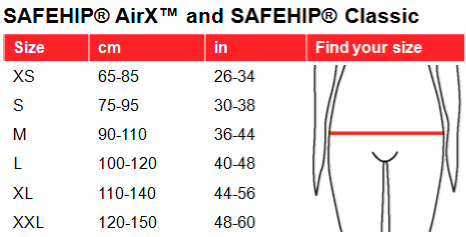
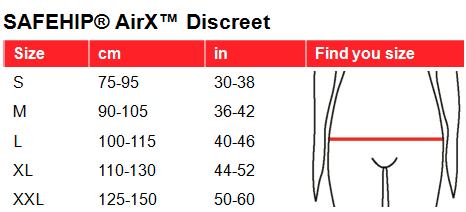
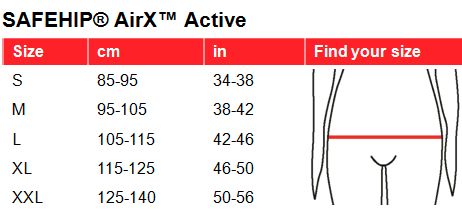
24. How do you put SAFEHIP® on?
SAFEHIP® is easiest to put on by utilizing the shields as leverage and then pulling up around the waist.
25. Will wearing SAFEHIP® make the hips look bigger?
No, most wearers have stated that people didn't know that they had SAFEHIP® on.
26. Can SAFEHIP® be worn by incontinent persons?
SAFEHIP® is available in designs for medium to high incontinence – SAFEHIP® Classic Open and SAFEHIP® AirX™ Open.
27. How much wear do you get out of SAFEHP®?
SAFEHIP® will last between 80 and 100 washes.
28. What is different about SAFEHIP®?
The clinical evidence, support from thought leaders around the world and superior customer support are several reasons why SAFEHIP® is the most sold and available hip protector in the world.
.png)